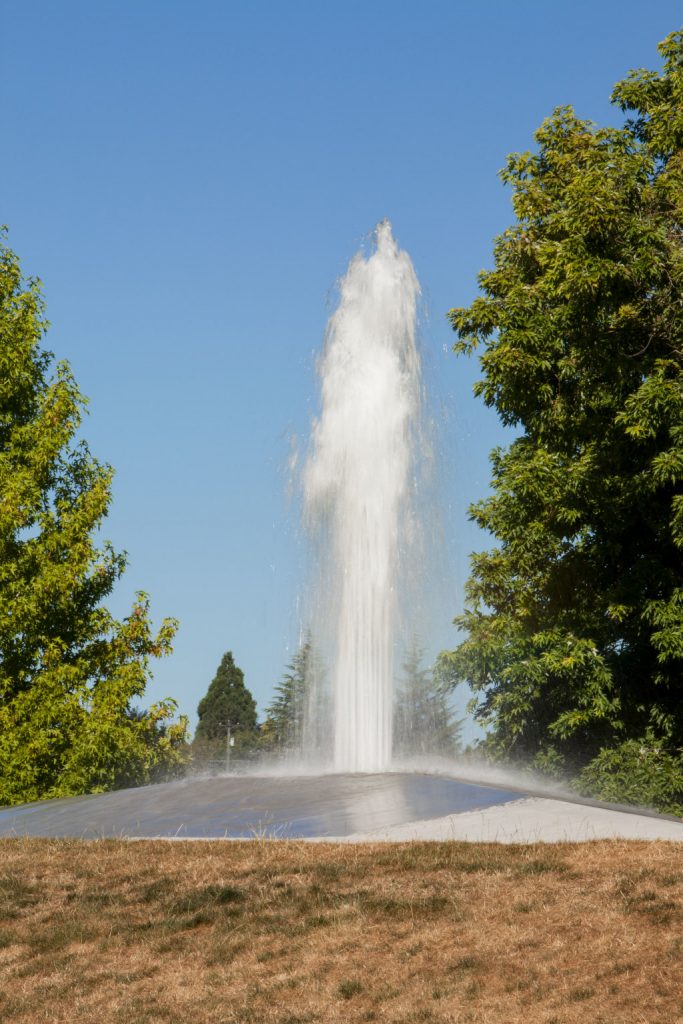While much of water-informed design lies within the realm of landscape architects and urban designers, architects also have a major role to play, especially in densely built urban centers. Within a building, water-informed design can lead to enhanced sustainability and lowered energy and water use while generating more livable interior spaces. Integration of architecture and landscape, a critical aspect of environmental design, can be achieved more holistically with water as a guide.
How does water play a role in Architecture?
The basics of water and architecture can be organized in two simple categories: Inside and Outside
Water inside architecture involves hot and cold drinking water, wastewater (greywater and blackwater), and may also include specialized water systems such as fire suppression, aesthetic applications, or water-based heating and cooling. While this blog cannot cover the details of all these systems, it is important to note that each one has standard, widely accepted methods of application that may be creatively tweaked to improve performance, sustainability, energy use and integration through collaborative design with engineers. For example, heat from shower-drain wastewater can be captured to aid in maintaining comfortable building temperatures, or grey water from sinks can be re-used to flush toilets. Understanding the full range and scale of water systems required at the schematic design phase of a building is critical to implementing these changes and devising water plans that decrease energy and water use while simultaneously increasing livability and design excellence.
Water outside architecture involves the structures and systems used to keep a building’s interior dry. At its most basic, this includes rainscreens, roofing, and drainage systems. There are thousands of options, both traditional and contemporary, for materials and build-ups for both roofing and rainscreens. These can be chosen or developed based on the building’s site-specific climate. Understanding the year-round water regime and climate of a site is critical in selecting the highest performing rainscreens and roofs while balancing embodied carbon.
A specific roofing type that has gained significant attention in recent years is the green roof. Green roofs use plants and soil above waterproofing layers to capture or slow down the flow of rainwater runoff from a building. This not only has a positive impact on the surrounding rainwater management systems, but also serves to reduce heat island effect, reduce energy use for interior cooling, purify the air, and support urban biodiversity1. Green roofs can be on a spectrum between extensive or intensive. Extensive green roofs involve smaller plants in shallower soil, with a lighter structural requirement and usually less maintenance. Intensive green roofs have deeper soil layers and may include shrubs and trees, along with pathways and occupiable space. These may require irrigation during drier seasons (Lampert 2019). For further information on green roofs and how they connect with other nature-based rainwater systems, please visit the Rainwater Management blog page.
1. US EPA, “Using Green Roofs to Reduce Heat Islands.”
2. Lampert, “A Guide to Green Roofs.”
How can inside and outside water systems be integrated?
Integration of inside and outside water systems can reduce water and energy use, improve quality of life, reduce environmental impact, and meaningfully integrate a building into its surrounding context. There are numerous precedents of novel ways architects and landscape architects have integrated indoor and outdoor systems. One of the most common ways is rainwater capture and reuse, whereby a buildings drainage systems collect rainwater to store, either using it outright to flush toilets or irrigate surrounding gardens or purifying it for potable water uses. Within a building, separating greywater and blackwater systems can allow for greywater to be recycled, both internally and externally, and could contribute to water elements in the surrounding landscape. This also reduces the volume of water entering sewers. Note that there are often municipal bylaws that govern the recycling of greywater and rainwater. During the schematic design phase of a building, it is important that architects and landscape architects together devise ways that inside and outside water systems can be woven together in a way that contributes to the surrounding context.

Inside, outside, and linked water systems can also be used to generate and inform the aesthetics of architecture. Architects have employed water aesthetically for thousands of years, often linked to the way that water impacts light.
Sources
Lampert, Eve. “A Guide to Green Roofs: The Lowdown on Types, Components and Advantages,” April 18, 2019. https://greenbuildingcanada.ca/guide-to-green-roofs/.
US EPA, OAR. “Using Green Roofs to Reduce Heat Islands.” Overviews and Factsheets, June 17, 2014. https://www.epa.gov/heatislands/using-green-roofs-reduce-heat-islands.
Global Water. “Difference between Blackwater and Greywater.” https://www.globalwatergroup.com.au/our-blog/difference-between-blackwater-and-greywater.
Additional Resources
Architizer. “Let It Pour: 8 Architectural Details to Harvest Rainwater” June 29, 2018. https://architizer.com/blog/inspiration/collections/rainwater-collection/.
A series of helpful precedents where water collection is incorporated meaningfully into a building’s design.
Elemental Green. “The Complete Beginner’s Guide to Greywater Systems,” October 21, 2016. https://elemental.green/complete-beginner-guide-to-greywater-systems/.
The basics of greywater reuse, with helpful point-form notes to guide design of systems.
Olshavsky, Peter. “Allure of Water: An Interview with Steven Holl.” Journal of Architectural Education 74, no. 1 (March 12, 2020): 149–53. https://doi.org/10.1080/10464883.2020.1693847.
An interesting interview, mostly focus on the aesthetic qualities of water in architecture.
Roehr, Daniel and Fassman-Beck, Elizabeth. Living Roofs in Integrated Urban Water Systems. London: Routledge, 2015. https://doi.org/10.4324/9781315726472.
A crossover resource also on the Rainwater Management blog, illustrating the role that green roofs play in larger urban landscapes.
Wilson, Alex. “Rainwater Harvesting.” BuildingGreen, May 1, 1997. https://www.buildinggreen.com/feature/rainwater-harvesting.
The basics of rainwater harvesting, including some historic methods.
Precedents
Hillcrest Geyser: Vanessa Kwan, Erica Stocking
Location: Vancouver, BC, Canada

An artificial geyser installed near a community center interrupts the flow from municipal water sources, indicating each time that the building draws on city water to supplement its extensive grey water and rain water re-use system.
Project can be viewed here and here.
On the Brooks House: Monsoon Collective
Angamaly, India

At the residential scale, this house draws the flow of rainwater runoff right through the building, centralizing that ephemeral, seasonal experience for the residents.
This project can be viewed here.
